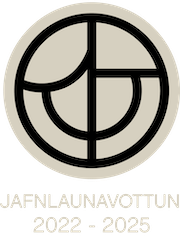Hverflyndir vinir. Að aftengja trú, siðferði og samfélag í Norðri á miðöldum - verkefni lokið
Fréttatilkynning verkefnisstjóra
Who doesn’t think of barbarity when they think of Vikings? For all their philosophical and artistic sophistication, not to mention mercantile success, the peoples of early medieval Scandinavia and Iceland are far more associated with crimes like violence, theft and murder. Part of that perception, for a long time, stemmed from the pagan religion that many followed in the Viking Age.
Over the course of the project ‘Fickle Friends’, I have sought to understand the reality of that situation. What were the moral outlooks of early Northerners? How much were they generated by their religion? Did worshippers think that gods like Freya, Odin or Thor cared about their behaviour? The answer, naturally, is complex.
Early northern morality is much like that of many other societies, though of course adapted to their circumstances. Murder, theft and violence are often transgressions, for example, yet, when conflict arises with an outside group, each of these potential wrongdoings can be valorized. Sharing and other sorts of kindness were the basis of strong communities, and these were actually stimulated by groups conducting religious rituals together, especially when these ceremonies involved a personal cost. Moral behaviour might have affected an individual’s afterlife; probably the idea of Valhalla, a paradise for dead warriors, made bands of fighters stronger and reinforced their internal hierarchy. Religious behaviours and views might have been part of why northern martial groups could outcompete others. The literary evidence is fragmentary and mostly relates to the upper classes, but the gods probably were believed to have an interest in human morality. Royal conduct is especially rewarded or punished in early poetry with ramifications for the land and its people too, leaders seemingly perceived as intermediaries for the gods. However, this reflects the wider importance given to individuals living up to their social responsibilities; again, this likely has the side-effect of reinforcing a rigid social hierarchy. Gods were interested in a wide range of behaviours, however, from altruism and bravery to the devotion they were due from their worshippers. No god had sole responsibility over morality. Likely the interest of a god was seen as circumstantial and could even extend to fate. Despite a long-standing perception of Old Norse fate as fixed and unavoidable, a surprising amount of evidence suggests that fate could be a punitive force too, changing to punish wrongdoers for infractions like avarice, kin-slaying or breaking oaths.
Information on how the results will be applied:
I will continue to publish these results over at least the next year, and many further findings and
avenues for research have presented themselves that I have not had time to completely pursue, so probably the project will continue to bleed into my work for years to come. My next project is on warrior culture, and my findings are a natural basis for that research, given that both projects relate to conduct, perception and social structure. Because my work is being published in high-ranking and open access journals, I hope that it will have a wider impact on the academic community as well, and I would like to extend this even further to the general public both through the engagement activities I have already completed over the last three years and through future enterprises.
A list of the project’s outputs:
Articles:
‘Viking Age Religion’, A Viking Life, edited by Irene García Losquiño (Exhibition Catalogue:
forthcoming summer 2024) ‘Healing with a hammer: Proposing an Old Norse theology’ (submission: October 2024)
‘Life, death, and human morality according to Old Norse mythology: The impact of afterlife beliefs on behaviour in the Viking Age’ (submission: summer 2024)
‘Morality and Old Norse religion’ (in preparation)
‘What do the nornir care? Fate, morality and supernatural punishment in the Poetic Edda’, Saga-Book (forthcoming 2024) (with Felix Lummer) ‘Conference Report – New Approaches to the Mind in the Early North’, Retrospective Methods Network (forthcoming 2024)
‘Siðr, Religion and Morality’, Gripla, 34 (2023): 7–36.
‘Religion in the Viking Age moral economy: A reading of a lausavísa by Egill Skallagrímsson’,
Religionsvidenskabeligt Tidsskrift, 74 (2022): 433–58.
‘The early Icelandic moral economy according to the poetry of Egill Skallagrímsson’, The Journal of
English and Germanic Philology, 121 (2022): 295–320.
‘Bonding over a death: Signalling in the funeral episode of Ibn Faḍlān’s Risala’, Early Medieval
Europe, 30 (2022): 437–60.
‘Did a little birdie really tell Odin? Applying Theory of Mind to Old Norse religion’, Journal of
Cognition and Culture, 21 (2021): 370–98. A book (in preparation)
International conference:
‘New Approaches to the Mind in the Early North’, 11–12 May 2023
Children’s book: (with Irene García Losquiño) Kara the Viking and Other Stories (Child Be Strange, in preparation)
Podcast interview:
‘Thor with Declan Taggart’, The Medieval Podcast, 8th June 2023
Twitch commentary:
‘God of War Ragnarök’, Twitch.tv, 9th December 2022
Three conference presentations, one internal presentation at the University of Iceland Centre for
Medieval Studies’s Lecture Series and a public lecture.
Heiti verkefnis: Hverflyndir vinir. Að aftengja trú, siðferði og samfélag í Norðri
á miðöldum /Fickle friends: Disentangling religion, morality and society in
the early medieval North
Verkefnisstjóri: Declan Taggart, Háskóla Íslands
Tegund styrks: Nýdoktorsstyrkur
Styrktímabil: 2020-2022
Fjárhæð styrks kr. 29.078.000
Tilvísunarnúmer Rannsóknasjóðs: 207157


